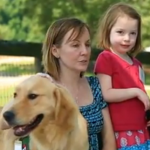Written by Senior Editor Peter Gehr
I’ve just finished watching a video that I’d recommend for every dog lover on the planet. In fact, I’d recommend it for any caring, compassionate individuals who want to either see people being helped by service dogs, or to participate in canine assistance for achieving independence.
If you’ve ever had a dog, you know that they have natural intuitions that are special and even inexplicable. Our furry friends have an amazing ability to sense our feelings of joy and sadness, sickness and health, natural calamities, and an uncanny instinct to perceive instances long before they happen.
I recently met an elderly woman who told me about how her neighbors dog helped save her life by waking up his owner and to alert them of this woman having fallen badly on the bathroom floor at 2am in the morning. She had apparently gotten up for “nature’s call” and decided not to use her walker and consequently fell backwards, striking her head on the bathroom floor. She managed to pull herself to the bedside and reach for her phone, but the batteries had died and the emergency buzzer to call for medical help was out of reach on the kitchen table.
Canine Assistance for Achieving Independence. A Dog Could Be the Answer for You or Your Loved One.
This video below is well worth watching and if you love dogs and love people, it’s a must see. Victoria Stilwell interviews director of Canine Assistants, Jennifer Arnold, director and author of “In a Dog’s Heart” and takes you into the lives of service dogs and their owners.
In a great deal of pain, Sally decided the only thing she could do was to use the phone to tap on the wall of the apartment as she lie there on the floor with broken ribs and bleeding head. She had little strength to make much noise by tapping on the wall, but her hope was that someone would hear it.
However, no one but the neighbors dog could hear the light tapping on the other side of the wall, but he sensed that something was wrong and that Sally needed help.
Incessant barking finally woke the neighbors who noted their dog barking at the wall. They went next door to find Sally in a serious condition and called for medical help.
It’s moments like these that one has to acknowledge the special powers of sensitivity that dogs possess, and to harness this ability is exactly what the people at Canine Assistants do. Based in Atlanta, Georgia, this non-profit organization has developed techniques to provide canine assistance for achieving independence for all sorts of needs. People with physical disabilities, problems with seizures, and many other special needs are provided with dogs, (primarily Golden Retrievers and Labradors), to help them in their everyday lives.
Purchase your copy of “In a Dog’s Heart” or, “Through a Dog’s Eyes” to help support this worthy cause.
Please hit the LIKE button below, and share with your Facebook friends. Thanks!






